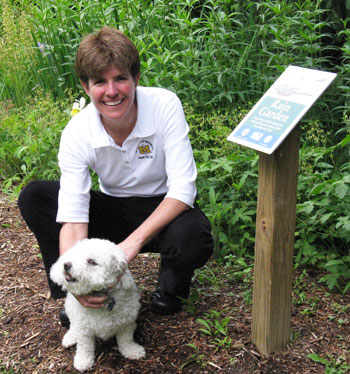Column: Seeds & Stems
Cecilia Sauter’s rain garden solved the problem of a wet and mushy side yard at her Ann Arbor home and may have helped her neighbor with water in her house’s foundation. Greg Marker, of Ypsilanti, uses a rain garden to hold runoff from three sump pumps and his house’s gutters, which resolves some water problems with his neighbors who live down the hill from him.
I just wanted to get rid of some lawn.
The thread that ties the three of us together is that we got help from Washtenaw County’s Office of Water Resources Commissioner (formerly the Drain Commissioner), which provided us with rain garden designs and helped us buy the native plants called for by the plans. The county’s program started in 2005, and so far it’s helped set up about 50 rain gardens.
No, a rain garden doesn’t grow precipitation. It takes care of water running off roofs and driveways, or pooling where no one wants water to pool. Basically, you dig a shallow bed – 3 inches deep with a flat bottom – and direct the rain into the bed where it can soak into the soil instead of running into the storm drains or making a mess in your basement.
With a rain garden, the water soaks slowly into the soil and ultimately into the ground water, instead of cascading down the storm drains and into local streams and rivers, taking things like fertilizers with it. There’s a bit of extra incentive for Ann Arbor residents: For homes with a rain garden, the city utilities department will cut your water and sewer bill by $2.80 every quarter.
Sauter’s rain garden accommodates the precipitation that falls on her roof and about half her next-door neighbor’s roof. The downspouts were routed underground and now empty into the rain garden that sprawls across the length of her back yard.

Cecelia Sauter and her dog Snowy in the the back yard of her northeast Ann Arbor home, where she has put in a rain garden.
The rain garden is constructed so that water fills up one end of the bed, then spills into the other half. That happened the first year, Sauter said, but this year, even with all the rain that fell this spring, the first half of the garden has pretty much taken care of all the water.
Now her side yard is dry, said Sauter, and another neighbor, who used to have a wet foundation in the rainy seasons, now seems to have no problems. As an added plus, there are plants blooming in her yard all season, from wild geraniums to the Joe Pye weed. ”It is awesome,” said Sauter.
Marker, a civil engineer, knows something about water, and he had an idea of how to channel the rain that would run off his property and onto his downhill neighbors. The pear-shaped rain garden he installed several years ago handles runoff from his entire roof, as well as the water from three sump pumps that carry water from the footing drains under his basement.
Before the rain garden, all that water “left me with a soggy yard,” said Marker. In the winter, “the sump water would come out (of the ground) two or three houses down and ice up.” Now the water goes into the rain garden and soaks more slowly into the soil.
There was a slight problem with the rain garden in the winter, when the ground froze. Though the outside temperature was below freezing, the water pumped up from underground was a steady 58 degrees, Marker said, and it just ran out over the frozen garden.
But Marker set up a system of valves, and each winter he redirects the sump water from the rain garden to a pipe that takes it to the storm drain that runs under the nearby street. Each spring, he directs the sump water back in the garden, where it warms the soil and gives an early boost to the plants there.
The county rain garden project is run by Harry Sheehan, an environmental manager at Water Resources, who came to my house last summer to start the process of building my rain garden. His office provided a landscape designer, Janis Das of InSite Design, who came up with the shape of the garden and a selection of native plants. (This year, the county will use Master Gardeners to design the gardens.)
Sheehan also helped me lay out the design on my lawn and had an intern with a Rototiller available to help rip up the grass. I also got a discount on the plants, which were purchased through the county. The design was meant to capture the water coming off half my roof and from one of my neighbor’s downspouts. The water normally runs along one side of the driveway, and now that water should run through a rock-filled trench into the rain garden.
I was responsible for digging the bed, which had to be at least 3 inches deep and flat. Flat. That’s what had me standing in the yard, raking the bed like one of those little Zen gardens. I would rake, then measure, then rake, then move the stakes used to measure the depth and rake again.
It gave me a chance to get caught up with my neighbors, who all wanted to know if I was installing a pond – ”A koi pond?” asked one neighbor. It’s planted now, and if Sauter and Marker are to be believed, the sweetspire, anemones and geraniums will be handling quite a bit of water that would normally run into the street’s storm drain.
The plants in the rain garden have to be able to take the hot, sunny conditions of high summer in my front yard, which faces southwest. But they also have to handle a rush of rain water that can come anytime from April to October.
I’ve mulched it all, but I expect there will be some small touches – such as adding a pile of rocks for contast and making the garden look a little less like a volcano (a neighbor’s description – I didn’t see it until he said it). I’ve also got to get out there and pull up the many maple seedlings that have recently sprung up.
After the last few heavy rains, I think the only change I’ll make is to enlarge the trench that leads into the rain garden bed.
The county has posted more information online, including a video tour of several local rain gardens installed under the program, with a list of plants and the garden designs. This year, Sheehan plans on helping another 10 rain gardens become reality. If you’re interested, email him at sheehanh@ewashtenaw.org to see if you can get on his list.
About the writer: Marianne Rzepka, former reporter for the Ann Arbor News and Detroit Free Press, is a Master Gardener who lives in Ann Arbor and thinks it’s fun to turn the compost pile.





RZ: Nice to see you in A2 journalism once again. Sad about the demise of the News. Not sure how else to contact you, trying to get you to bring Norm out to Hardly Strictly Bluegrass some October.
Cheers
Doug Elinson
delinson[at]sbcglobal[dot]net